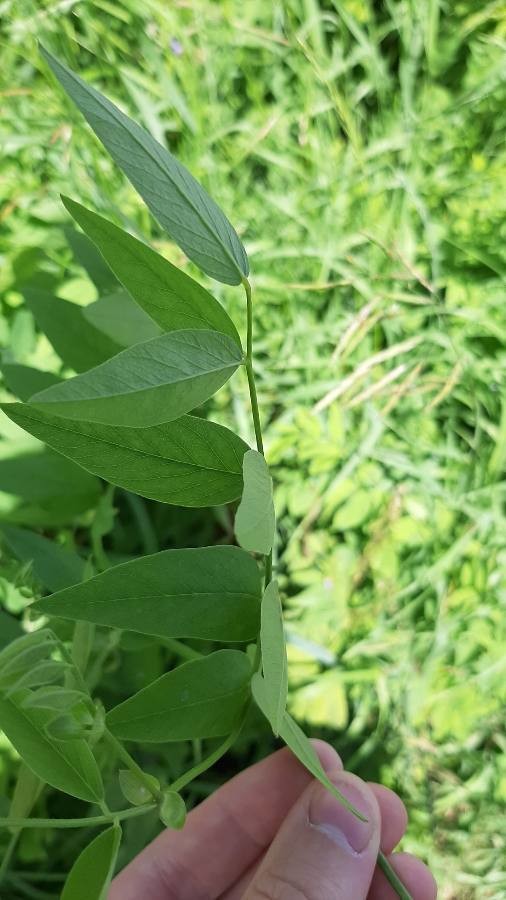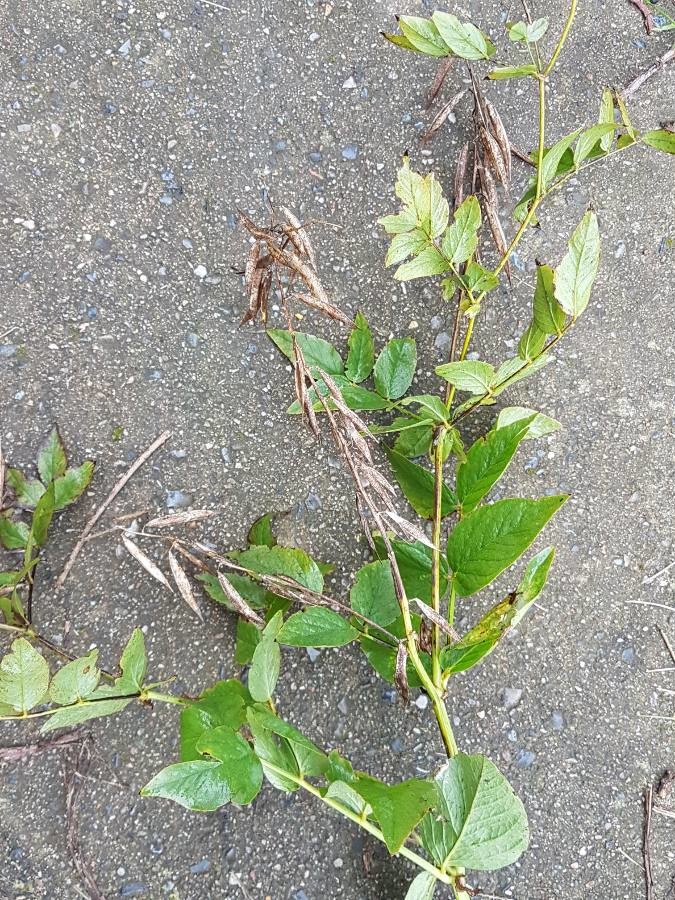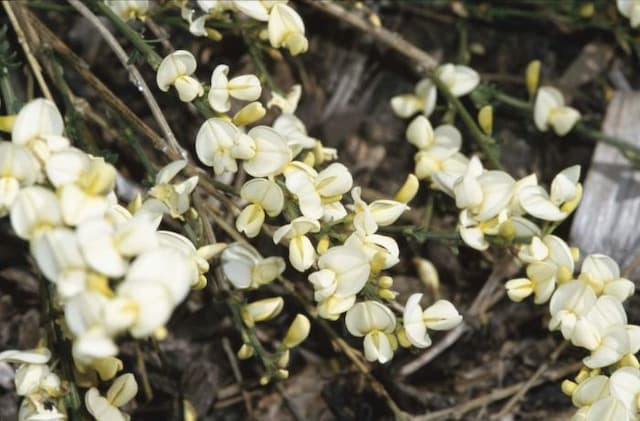Goat's Rue Galega orientalis






ABOUT
Galega orientalis, commonly known as East Asian milkvetch, is a perennial plant that is recognized for its striking appearance. The plant typically features an abundance of pinnate leaves, which comprise numerous pairs of small, oblong leaflets. These leaflets are often bright green, offering a lush appearance. Throughout its blooming period, the East Asian milkvetch becomes particularly attractive due to its profusion of delicate flowers. These blossoms are shaped like small tubes that flair into a classic pea-flower shape, and they usually display colors ranging from pale lavender to a soft, bluish-purple, sometimes with white accents making them quite eye-catching. The flowers are clustered together on a long, upright stem, creating an inflorescence that adds a vertical element to its overall form. Beyond its floral display, the plant may also produce narrow, elongated seed pods that hang down from the flowering stems. These pods can provide additional textural and visual interest to the plant as they mature. The overall appearance of the East Asian milkvetch is one of delicate beauty, with an intricate leaf structure and a profusion of whimsical flowers that bring a touch of elegance to any setting in which it grows.
About this plant
 Names
NamesFamily
Fabaceae
Synonyms
Goat's Rue, East Galega
Common names
Galega persica, Galega bicolor, Galega speciosa, Galega sibirica.
 Toxicity
ToxicityTo humans
Galega, commonly known as Goat's Rue, contains guanidine derivatives which are toxic to humans. If ingested, they can cause symptoms such as sweating, vomiting, weakness, and respiratory depression. Chronic ingestion can lead to more severe consequences, including organ damage.
To pets
Goat's Rue is also toxic to pets, including cats and dogs. Symptoms of poisoning after ingestion can include vomiting, diarrhea, lethargy, abdominal pain, and possibly more severe symptoms like difficulty breathing and changes in heart rate. Ingesting Goat's Rue can lead to serious health issues for pets and should be treated promptly by a veterinarian.
 Characteristics
CharacteristicsLife cycle
Perennials
Foliage type
Deciduous
Color of leaves
Green
Flower color
Blue
Height
2-3 feet (60-90 cm)
Spread
2 feet (60 cm)
Plant type
Herb
Hardiness zones
4
Native area
Caucasus
Benefits
 General Benefits
General Benefits- Nitrogen Fixation: Galega orientalis, commonly known as Goat's Rue, has the ability to fix atmospheric nitrogen, improving soil fertility.
- Forage Crop: Goat's Rue can be used as a high-protein forage for livestock, although it must be managed carefully to prevent toxicity.
- Landscape Beautification: With its attractive flowers, Goat's Rue adds aesthetic value to gardens and landscapes.
- Pollinator Attraction: The flowers of Goat's Rue are a nectar source for bees and other pollinators, supporting biodiversity.
- Erosion Control: The plant has a deep rooting system that can help stabilize soil and prevent erosion.
- Phytoremediation: Goat's Rue has been studied for its potential in phytoremediation, the use of plants to remove contaminants from the environment.
 Medical Properties
Medical Properties- Galactagogue: Galega orientalis has been used traditionally to increase milk production in nursing women.
- Antidiabetic: There is some evidence that the plant may have effects on lowering blood sugar levels, hence its historical use in treating diabetes.
- Diuretic: The plant has been used as a diuretic to help with the elimination of excess water from the body.
 Air-purifying Qualities
Air-purifying QualitiesThis plant is not specifically known for air purifying qualities.
 Other Uses
Other Uses- Galega orientalis, commonly known as East Asian goat's rue, can be utilized as a forage crop, providing a source of feed for livestock due to its rich nutritional content.
- The plant can be used as green manure, improving soil fertility by fixing nitrogen and adding organic matter when it decomposes.
- The dense foliage of East Asian goat's rue can provide ground cover, reducing soil erosion and suppressing weed growth in agroforestry systems.
- Gardeners might use East Asian goat's rue for ornamental purposes, as it produces attractive flowers that can enhance the visual appeal of gardens and landscapes.
- Because of its rapid growth, East Asian goat's rue can be used for biomass production, contributing to renewable energy resources.
- The flowers of Galega orientalis can be a source of nectar for bees and other pollinators, supporting biodiversity within the ecosystem.
- In some regions, it can be used in traditional textile dyeing processes for adding green hues to fabrics, although it's not a common practice.
- Due to its vigorous growth, East Asian goat's rue might be planted as a pioneer species in reclamation sites to help restore degraded lands.
- The woody stems of established plants could potentially be harvested and used as a low-grade material for making paper or cardboard.
- Some artisans might use the dried seed pods of East Asian goat's rue in decorative crafts or as part of floral arrangements.
Interesting Facts
 Feng Shui
Feng ShuiThe Galega orientalis, commonly known as goat's rue, is not used in Feng Shui practice.
 Zodiac Sign Compitability
Zodiac Sign CompitabilityThe Galega orientalis, commonly known as goat's rue, is not used in astrology practice.
 Plant Symbolism
Plant Symbolism- Hardiness: Galega orientalis, also known as goat's rue, thrives in various conditions demonstrating resilience and the ability to overcome adversity.
- Adaptability: This plant's capacity to grow in different soil types symbolizes flexibility and the willingness to adapt to diverse environments.
- Medicinal properties: Historically used for medicinal purposes, goat's rue represents healing and the alleviation of ailments.
- Purification: Due to its use in traditional medicine to treat various diseases, it can symbolize cleansing and purity.
 Water
WaterGoat's rue requires consistent moisture, especially during its active growing season in spring and summer. Water the plant deeply once a week, ensuring that the soil is moist but not waterlogged. Approximately 1 to 1.5 gallons of water should be sufficient for each watering session, depending on soil type and weather conditions. In hotter, drier periods, you may need to water more frequently, while in cooler, wetter times, you may water less. Always check the top inch of soil for dryness before watering again.
 Light
LightGoat's rue thrives in full sun to partial shade. The ideal spot for this plant is in an area where it receives at least 6 hours of sunlight per day, but it can also tolerate some afternoon shade. Avoid deep shade locations, as this will affect the plant's ability to flower.
 Temperature
TemperatureGoat's rue prefers temperate climates with temperatures ranging between 50°F and 85°F. It can tolerate minimum temperatures down to around 20°F, but frost can damage the plant. The ideal temperature range for this plant to thrive is between 60°F and 75°F.
 Pruning
PruningPruning goat's rue is important to encourage bushier growth and to prevent it from becoming too leggy. Trim back the plant after flowering to promote a second bloom and to maintain its shape. The best time for pruning is late winter or early spring, just as new growth begins to appear. Generally, pruning once a year is sufficient for maintaining a healthy plant.
 Cleaning
CleaningAs needed
 Soil
SoilGoat's rue thrives best in a well-drained soil mix with a pH ranging from slightly acidic to neutral, around 6.0 to 7.0. A high-quality garden soil amended with compost and possibly perlite or sand to increase drainage is ideal for this plant.
 Repotting
RepottingGoat's rue does not require frequent repotting and can typically be repotted every 2 to 3 years or when it outgrows its current container.
 Humidity & Misting
Humidity & MistingGoat’s rue prefers moderate humidity but is relatively tolerant of various humidity levels as long as proper soil moisture is maintained.
 Suitable locations
Suitable locationsIndoor
Ensure bright indirect light and sufficient space for Goat's rue growth.
Outdoor
Choose a sunny spot, water well, and protect from strong winds for Goat's rue.
Hardiness zone
4-8 USDA
 Life cycle
Life cycleGalega orientalis, commonly known as Oriental goat's rue, begins its life as a seed, germinating in favorable soil conditions with ample moisture and light. Upon sprouting, the seedling grows into a herbaceous perennial with tall, erect stems, developing compound leaves with lance-shaped leaflets. Throughout the summer, the plant enters a vegetative growth phase, where it focuses on producing dense foliage and strengthening its root system. Following this period, it enters the reproductive stage, blooming with small, attractive blue to violet flowers typically from June to August, attracting various pollinators. After pollination, the flowers develop into seed pods that mature and eventually release seeds, completing the sexual reproduction cycle. During the winter or unfavorable conditions, the above-ground parts may die back, while the root system remains alive, enabling the plant to regrow and repeat the cycle in the following season.
 Propogation
PropogationPropogation time
Spring to summer
Propogation: The most popular method of propagation for Galega orientalis, commonly known as Oriental goat's rue, is by seed. Seed sowing should be done in spring after the risk of frost has passed. To initiate propagation, disperse the seeds over a well-draining soil mix and lightly cover them with additional soil. Water the seeds gently to moisten the soil without causing the seeds to wash away. Seedlings will emerge in a few weeks and should be thinned out to prevent overcrowding. For optimal growth ensure they are kept in a sunny location with moderate moisture until they are strong enough to be transplanted into the garden or desired area.









